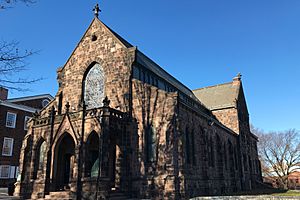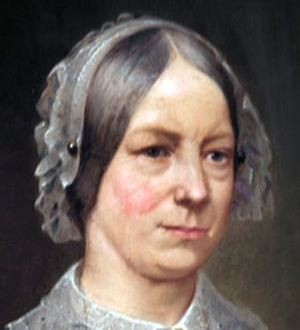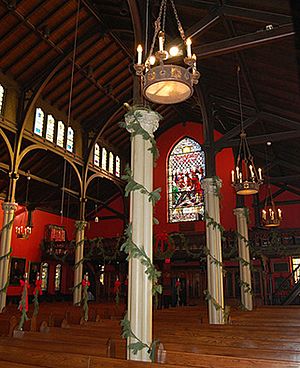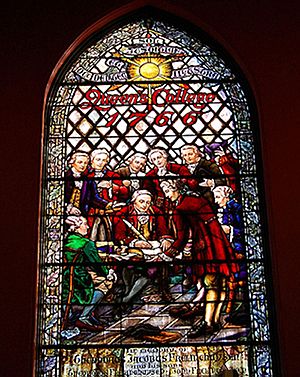Kirkpatrick Chapel facts for kids
Quick facts for kids Sophia Astley Kirkpatrick Memorial Chapel |
|
|---|---|

Kirkpatrick Chapel in 2018
|
|
| Religion | |
| Affiliation | Non-denominational |
| Year consecrated | 1873 |
| Status | University chapel |
| Location | |
| Location | Queens Campus, Rutgers University, New Brunswick, New Jersey |
| Architecture | |
| Architect(s) | Henry Janeway Hardenbergh |
| Architectural style | Gothic Revival |
| Funded by | Bequest from Sophia Astley Kirkpatrick |
| Completed | 1873 |
| Construction cost | $52,204.57 (2013: US$1,003,893.88) |
| Specifications | |
| Capacity | 650 |
| Length | 116 feet (35 m) |
| Width | 57.5 feet (18 m) |
| Height (max) | 55 feet (17 m) |
| Materials | Brownstone |
|
U.S. Historic district
Contributing property |
|
| Lua error in Module:Location_map at line 420: attempt to index field 'wikibase' (a nil value). | |
| Part of | Queens Campus, Rutgers University (ID73001113) |
|---|---|
| Designated CP | July 2, 1973 |
The Sophia Astley Kirkpatrick Memorial Chapel, often called Kirkpatrick Chapel, is a special building at Rutgers University in New Brunswick, New Jersey. It's one of the oldest buildings on the university's historic Queens Campus. The chapel was built in 1872 when Rutgers was a smaller, private college.
A talented architect named Henry Janeway Hardenbergh designed the chapel. He was from New Brunswick and was even related to Rutgers' first president! The chapel was named after Sophia Astley Kirkpatrick, whose generous gift helped pay for its construction. She left money to Rutgers when she passed away in 1871. This was the first time in New Jersey history that a school directly inherited money from someone's will.
The chapel was built in the Gothic Revival style, which was popular in the mid-1800s. This style looks like old European churches from the 1300s. The chapel is famous for its beautiful stained glass windows, some of the first made in America with special colorful glass. Four of these windows were even made by the famous artist Louis Comfort Tiffany. Kirkpatrick Chapel is part of the Queens Campus Historic District, which became a protected historic place in 1973.
For its first 30 years, the chapel was used as both a library and for daily church services. Even though Rutgers started as a college connected to a specific church, today it's a public university open to everyone. The chapel welcomes students, alumni, and teachers of all faiths. It's also used for many university events like concerts, weddings, and important speeches.
Contents
History of Kirkpatrick Chapel
The Kirkpatrick Family and Rutgers
Sophia Astley Kirkpatrick (1802–1871) passed away in 1871. In her will, she left a significant amount of money to Rutgers College. At that time, Rutgers was a small, private college in New Brunswick, New Jersey. It was connected to the Dutch Reformed Christian faith. Rutgers was founded in 1766 as Queen's College, making it one of the oldest colleges in the United States.
Sophia was the daughter of a wealthy merchant. She married Littleton Kirkpatrick (1797–1859) in 1832. Littleton was a lawyer and came from an important family in New Brunswick. He was also involved in politics, serving as mayor and even in the U.S. House of Representatives. He was a trustee for Rutgers College for 18 years until he passed away in 1859. Sophia stayed in New Brunswick after her husband's death. She was known for her kindness and charity.
The Kirkpatrick family had a long history with Rutgers. Many family members attended the college or served as trustees. For example, Littleton's father, Andrew Kirkpatrick, taught at the Queen's College Grammar School and was a trustee. Several of Littleton's nephews also studied at Rutgers.
How the Chapel Was Designed and Built
In 1870, the leaders of Rutgers College decided they wanted to build a chapel when they had enough money. Before this, chapel services were held in another building, but the student body was growing, so a bigger space was needed. When Sophia Astley Kirkpatrick passed away in 1871, her gift of over $61,000 made the chapel possible.
A young architect named Henry Janeway Hardenbergh (1847–1918) was hired to design the chapel. He was just starting his career. Hardenbergh had family ties to Rutgers; his great-great-grandfather, Rev. Jacob Rutsen Hardenbergh, was the first president of the college. Henry Hardenbergh had already designed two other projects for Rutgers. He later became very famous for designing large hotels and skyscrapers, including New York City's Plaza Hotel.
Kirkpatrick Chapel was built on a hill where it's believed Alexander Hamilton once placed cannons during the Revolutionary War. This was to help George Washington's soldiers retreat safely. The chapel was finished in 1873 and cost about $52,000.
When it first opened, the chapel could seat 350 people. The back part of the building also had classrooms, the college president's office, and a library. In 1916, the chapel was renovated to become one large assembly room. Walls were removed, increasing its capacity to 800 people, though today, fire codes limit it to 650.
The Chapel's Role Today
For its first 50 years, Kirkpatrick Chapel was used for daily worship services. As Rutgers grew, the daily services became less frequent. After World War II, Rutgers became a public university, no longer tied to a specific church.
Today, the chapel is used for many different university events. These include graduation ceremonies, lectures, and concerts. It's also a popular place for weddings, baptisms, and memorial services. Since 1876, graduating classes have carved their class year into a stone on the chapel's outside walls. The university's Kirkpatrick Choir and Rutgers University Glee Club often perform concerts there.
The Chapel as a Library (1873–1903)
When Kirkpatrick Chapel first opened, the second floor of its rear section served as the college's library. In 1876, the library had about 6,800 books. By 1894, the librarian, Irving S. Upson, reported that the library was too small for the growing collection. The trustees worried that the heavy books might even cause the floor to collapse!
By 1903, the library in the chapel was very crowded with 45,000 books. A generous couple, Ralph and Elizabeth Rodman Voorhees, donated money to build a new, much larger library. This new building, called Voorhees Hall, opened in 1903. It served as the main library until a new one, the Archibald S. Alexander Library, opened in 1956.
Important Events at the Chapel
- In 1881, the chapel hosted an important debate between Rutgers and New York University students about voting rights. Rutgers won!
- In 1957, famous American poet Robert Frost gave a poetry reading at the chapel.
- In 1981, Queen Beatrix of the Netherlands visited the chapel. Rutgers gave her grandmother, Queen Wilhelmina of the Netherlands, an honorary degree that had been awarded in 1941 for her bravery during World War II.
Chapel Architecture
Kirkpatrick Chapel was designed to match the Gothic Revival style of another building nearby, Geology Hall. Both buildings are made of New Jersey brownstone, a reddish-brown stone that was popular for buildings in New York City and New Jersey. Brownstone is easy to shape, which made it a good choice for detailed designs.
The chapel's design is a "restrained" version of Gothic architecture, meaning it avoids too many fancy decorations. The front of the chapel has a porch with three archways and strong supports called buttresses. It also has tall, narrow windows called lancet windows. The overall look is similar to an old English country church.
Inside, the chapel has a main area called a nave and side aisles. The roof is made of dark wood. The chapel is known for its "graceful interior" with light and delicate features.
Kirkpatrick Chapel is part of the Queen's Campus historic district. It was added to the New Jersey Register of Historic Places in 1973 and the National Register of Historic Places in 1973.
Inside the Chapel
The Organ
Since 1916, Kirkpatrick Chapel has had a large pipe organ. It's considered one of the best examples of its kind in New Jersey. In 1916, a donation of $10,000 helped pay for the new organ. It was built by the Ernest M. Skinner & Company of Boston, a top organ-builder at the time. The organ originally had 33 stops and over 1,600 pipes.
From 1958 to 1961, the organ was updated and rebuilt. It was expanded to have 59 stops and over 3,000 pipes! However, as of 2013, the organ had stopped working and was replaced temporarily with an electronic organ. Rutgers has been considering whether to fix the old organ or get a new one. In late 2019, a very old Appleton Organ from 1840 was purchased to replace it.
Stained Glass Windows
The chapel has many beautiful stained glass windows. About twenty of the tall, narrow windows along the sides were donated by graduating classes from the late 1800s and early 1900s. These windows show their class year and phrases in ancient Greek and Latin.
Four of the chapel's windows were made by the famous Louis Comfort Tiffany studios. These windows are special because they use "opalescent glass," which has more than one color fused together. One window shows Joan of Arc. Another large window above the altar, called "Jesus, the Teacher of the Ages," was also designed by Tiffany studios. It honors Rutgers' first president, Rev. Jacob Rutsen Hardenbergh.
A large window above the chapel's entrance celebrates the signing of the charter that created Queen's College (now Rutgers) in 1766. This "Charter Window" was donated by the Frelinghuysen family to honor their ancestors who helped establish the college.
The chapel's windows underwent a long restoration project that started in 2004.
Portraits and Memorial Plaques
Inside Kirkpatrick Chapel, you can find many portraits. An alumnus named Edward Sullivan Vail helped collect over sixty paintings. These include portraits of Rutgers presidents, important trustees, professors, and of course, Sophia Astley Kirkpatrick herself. Her portrait is the only one of a woman in this collection.
The chapel walls also have special plaques that remember Rutgers graduates who died while serving in wars. These plaques list the names of many brave men and women connected to Rutgers who gave their lives.




